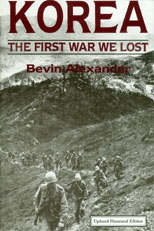 Click here to purchase from Barnes & Noble.
Click here to purchase from Amazon.com.
Click here to purchase from Barnes & Noble.
Click here to purchase from Amazon.com.
Bloody Ridge: a Quintessential Battle of the Korean War
Excerpt from Korea: The First War We Lost, by Bevin Alexander, pages 440-42
Background: In the summer of 1951 positional warfare had come to Korea. The Eighth Army commander, James A. Van Fleet, ordered 2nd Infantry Division of X Corps to eliminate a sag in the line, in the high Taebaek Mountains of eastern Korea. The original target was Hill 983, north of Inje.
On August 18 [1951], the ROK [Republic of Korea] 36th Regiment of the 5th Division, now attached to the U.S. 2nd Division, attacked Hill 983, southwest of the Punchbowl, the big two-mile-wide and three-mile deep mountain mass that was to acquire the name of Bloody Ridge from Stars and Stripes, the service newspaper.
The preliminary to this assault on Hill 983 was a days-long concentration of artillery fire which gradually eliminated practically every trace of vegetation upon the ridgeline, turning it into a brown landscape with skeletons of trees clawing the air. The ROKs attacked frontally up the fingers leading to the peak. The ROKs quickly established the pattern of battle that was to predominate in Korea for the next two years in hundreds of battles, engagements and sorties on mountains and ridges all across the front. The heavy artillery bombardments and air strikes had eliminated trees and underbrush, but had not destroyed the communist bunkers or all the thick minefields protecting the emplacements. The bunkers, constructed of heavy timbers, and usually covered with deep layers of rock and earth, were so massive that generally only a direct hit by the heaviest-caliber artillery was able to destroy them. Such direct hits were difficult, because the bunkers were hard to find in the torn-up ground. The most effective weapon against them was the 155mm Long Tom rifle. There were relatively few Long Toms available, and they could not always be placed in position for direct, low-trajectory fire. As a result, as soon as the ROKs got within range of the bunkers, the North Koreans struck at them with automatic-weapons fire and clouds of hand grenades, which they threw or rolled down the ridgelines at the attacking troops.
After five days of repeated frontal assaults against Bloody Ridge, the ROKs finally took it, but then had to withdraw because of heavy NK [North Korean] counterattacks. General [ Clark L.] Ruffner [2nd Division commander] had to commit parts of 2nd Division’s 9th Regiment to support the ROKs, but still the North Koreans refused to budge. The heavy casualties the ROK 36th Regiment suffered led to a sharp decline in morale, and on August 27 some units of the regiment broke and ran. This spread panic among parts of the 9th Regiment as well.
The new X Corps commander, Major General Clovis E. Byers, decided to apply pressure against the Reds across the whole corps front in hopes of forcing the enemy to disperse his firepower and prevent the steady buildup of troops on Bloody Ridge. He assigned the ROK 5h Division the mission of seizing the northwest rim of the Punchbowl and directed the 1 st Marine Division to capture the northeast rim. The 2nd Division meanwhile got the assignment to take Bloody Ridge, while the ROK 7th Division was to attack and capture terrain to the west of Bloody Ridge.
The marines were fortunate in attacking while NK units were in the process of being exchanged, and the leathernecks’ forceful assaults carried through and won control of the northern lip of the Punchbowl.
The 2nd Division’s attacks on Bloody ridge were again direct assaults. Although they were fierce and sustained, they failed to dislodge the North Koreans. The leading unit, the 9th Regiment, suffered heavy casualties, but could not drive the NK defenders away. Brigadier General Thomas E. de Shazo, who had taken command of the 2nd Division temporarily, laid out a double-envelopment plan, using the division’s 23rd and 38th Regiments, while the 9th Regiment continued the direct assault on the ridge. On September 4 and 5 the resolution came suddenly: the North Koreans, weakened by heavy losses, evacuated Bloody Ridge, leaving the bodies of five hundred dead comrades on the heights. In almost three weeks of fighting, the ROKs and Americans had suffered more than 2,700 casualties, while the communists had sustained an estimated 15,000.
For analysis of this battle and Heartbreak Ridge which followed immediately after, see the first paragraphs of the Introduction of How Great Generals Win, by Bevin Alexander (© 1993).]
<< More 'Korean War' Excerpts << Back to top